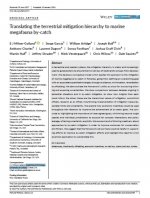Translating the terrestrial mitigation hierarchy to marine megafauna by-catch
View PublicationIn terrestrial and coastal systems, the mitigation hierarchy is widely and increasingly
used to guide actions to ensure that no net loss of biodiversity ensues from development.
We develop a conceptual model which applies this approach to the mitigation
of marine megafauna by-catch
in fisheries, going from defining an overarching goal
with an associated quantitative target, through avoidance, minimization, remediation
to offsetting. We demonstrate the frameworks utility as a tool for structuring thinking
and exposing uncertainties. We draw comparisons between debates ongoing in
terrestrial situations and in by-catch
mitigation, to show how insights from each
could inform the other; these are the hierarchical nature of mitigation, out-of-
kind
offsets, research as an offset, incentivizing implementation of mitigation measures,
societal limits and uncertainty. We explore how economic incentives could be used
throughout the hierarchy to improve the achievement of by-catch
goals. We conclude
by highlighting the importance of clear agreed goals, of thinking beyond single
species and individual jurisdictions to account for complex interactions and policy
leakage, of taking uncertainty explicitly into account and of thinking creatively about
approaches to by-catch
mitigation in order to improve outcomes for conservation
and fishers. We suggest that the framework set out here could be helpful in supporting
efforts to improve by-catch
mitigation efforts and highlight the need for a full
empirical application to substantiate this.

